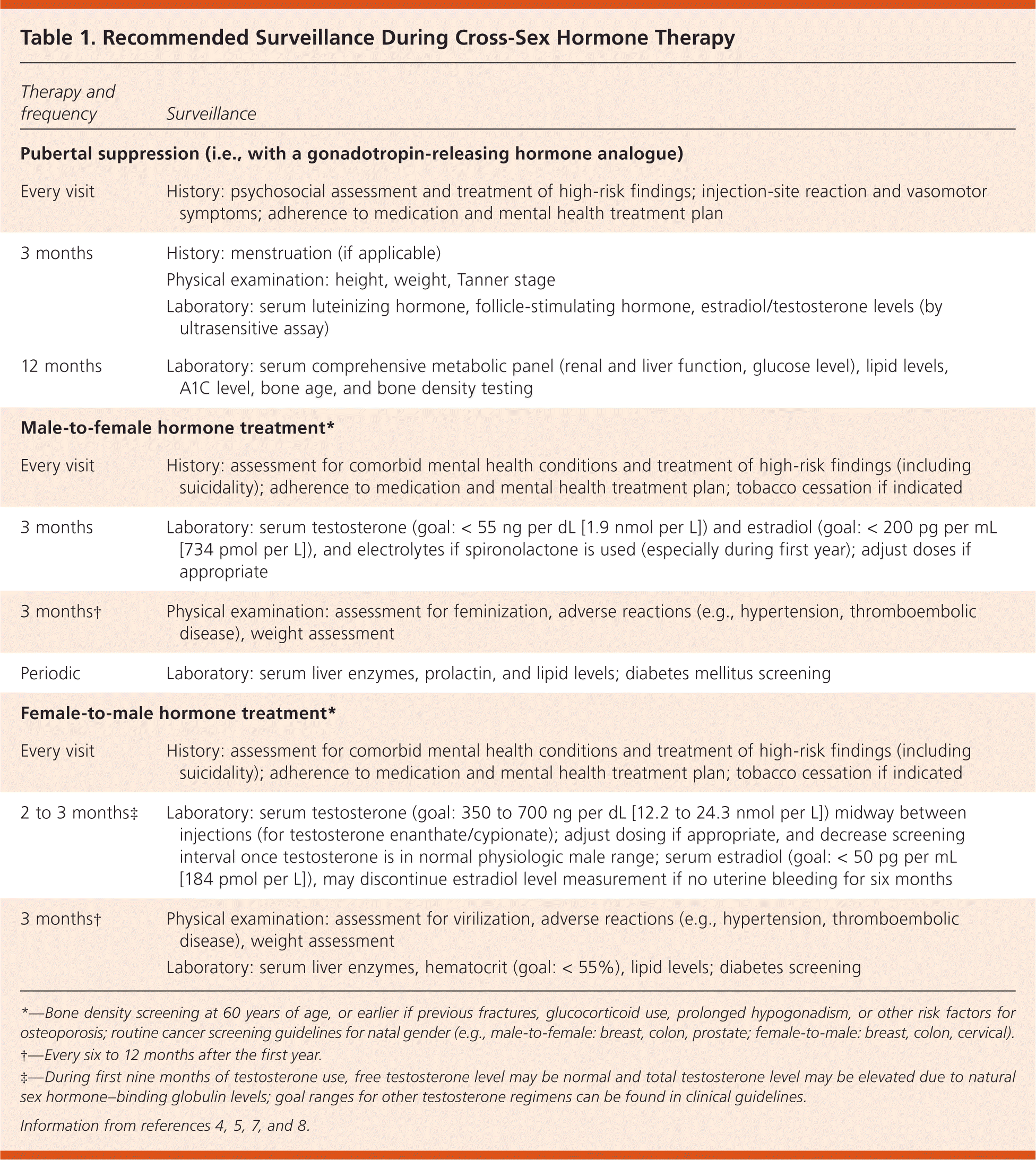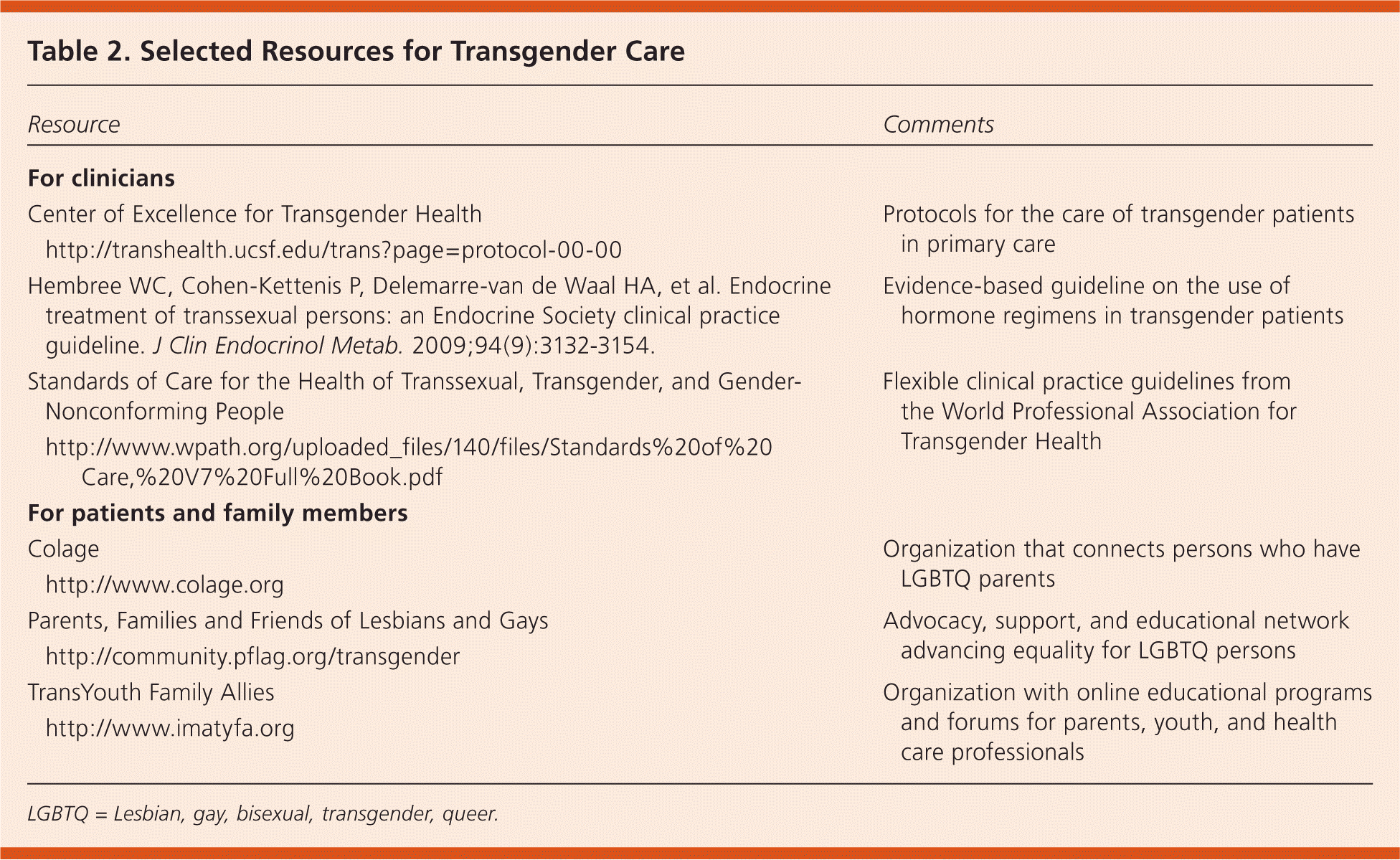
Am Fam Physician. 2015;92(2):142-148
Author disclosure: During the writing of this manuscript, Dr. Olson had no relevant financial affiliations with any drug or medical device manufacturer. After submission, Dr. Olson attended one meeting of the AbbVie Advisory Board as a consultant to describe the use of gonadotropin-releasing hormone analogues in transgender youth. She was compensated for this meeting, but does not have any ongoing financial relationship with AbbVie or any other relevant drug or device maker.
Case Scenario
A 19-year-old patient presented to my clinic with a request for cross-sex hormone therapy. Assigned at birth as female, my patient began a masculinizing gender transition during early adolescence. His parents were reportedly supportive, but bullying in high school led to depression, substance use, and, ultimately, bouts of homelessness. He reported using unregulated cross-sex hormones during insurance-coverage gaps. More recently, however, he has secured stable housing, minimum-wage income, and basic insurance through social services.
My patient attributed his current depression to gender dysphoria, which presented a dilemma. Although I suspected that not refilling his testosterone therapy would result in continued use of unregulated hormone therapy, a loss of confidence in the medical system, and worsening depression, neither I nor any of the referral clinicians in my community have been trained in transgender care. Our primary care clinic prides itself on providing nonjudgmental, comprehensive care to patients of all backgrounds; however, even after reviewing current guidelines on transgender care, I am uncertain whether I am qualified to help this patient. How should I approach his care?
Commentary
Although the actual number may be higher, research estimates that approximately 700,000 Americans are transgender.1 Many in this population have inadequate insurance to cover appropriate health care.2 The condition gender dysphoria (formerly known as gender identity disorder) occurs when one's experienced gender is incongruent with one's assigned gender.3 Individuals who transgress from gender norms may identify as transgender, and these patients appear to be presenting to the medical system at increasingly higher rates.4,5 As the presence of transgender men and women expands in the media, and acceptance within society broadens, patients are likely feeling more confident seeking health care that meets their needs.
Primary care clinicians treat transgender patients in their practices, and although not every clinician assumes a primary role in cross-sex therapy, it is important to be mindful of the following principles at each visit.
FOSTER RAPPORT
Some clinicians might find it helpful during the first visit to state, “Although I have limited experience caring for transgender patients, it is important to me that you feel safe in my practice, and I will do my best to give you the best care possible.” This may be followed by asking patients what name and pronoun they prefer, and whether they feel comfortable sharing their experiences concerning gender. Assumptions regarding sexual or romantic attraction or behavior should be avoided, because these variables do not necessarily correlate with a patient's asserted gender. Similarly, physicians should not assume that all transgender patients choose to undergo a physical transition.
OFFER CARE EARLY
Sexual-minority youth are often challenged by suicidality, body-image distortion, substance abuse, and high-risk sexual behavior, in part because of the effects of unsupportive environments.5,6 Most transgender health specialists recommend therapy in which clinicians affirm the patient's sense of self and exploration of gender identity.5–7 Particularly when raised in nurturing environments, sexual-minority youth are likely to be resilient and become healthy adults.6
Gender identity is fixed in early adolescence and beyond.5,7 Therefore, once gender dysphoria is confirmed, pubertal suppression may be accomplished in male and female adolescents with use of a gonadotropin-releasing hormone analogue. This treatment is reversible, allowing permanent decisions to be delayed until later in adolescence. Pubertal suppression can decrease stress associated with undesired pubertal development and make future transition safer and easier.4,5,7,8
MONITOR PSYCHOSOCIAL WELL-BEING
Transgender persons experience more mental health challenges and have a greater number of psychosocial stressors than the general population.7 Therefore, it is important to have a general discussion on mental well-being at every visit. In a study of more than 1,000 transgender patients, almost one-half reported symptoms of clinical depression. Those who found therapeutic and social environments that affirmed their gender identity and promoted resilience reported less psychological distress than those who did not.9
EMPHASIZE GENERAL HEALTH
Patients should be questioned about tobacco use and sedentary lifestyle and screened for hypertension, obesity, and hyperlipidemia. Each of these factors is especially important to monitor in patients undergoing a feminizing transition with estrogen therapy, because of a mildly increased risk of thromboembolic events.10 Patients who are under a clinician's care, compared with those who are not, may be less likely to use tobacco products, unsanitary needles, or unregulated hormone therapy.11 If at risk, patients should be screened for sexually transmitted infections.
REVIEW GUIDELINES FOR HORMONE THERAPY

| Therapy and frequency | Surveillance |
|---|---|
| Pubertal suppression (i.e., with a gonadotropin-releasing hormone analogue) | |
| Every visit | History: psychosocial assessment and treatment of high-risk findings; injection-site reaction and vasomotor symptoms; adherence to medication and mental health treatment plan |
| 3 months | History: menstruation (if applicable) |
| Physical examination: height, weight, Tanner stage | |
| Laboratory: serum luteinizing hormone, follicle-stimulating hormone, estradiol/testosterone levels (by ultrasensitive assay) | |
| 12 months | Laboratory: serum comprehensive metabolic panel (renal and liver function, glucose level), lipid levels, A1C level, bone age, and bone density testing |
| Male-to-female hormone treatment* | |
| Every visit | History: assessment for comorbid mental health conditions and treatment of high-risk findings (including suicidality); adherence to medication and mental health treatment plan; tobacco cessation if indicated |
| 3 months | Laboratory: serum testosterone (goal: < 55 ng per dL [1.9 nmol per L]) and estradiol (goal: < 200 pg per mL [734 pmol per L]), and electrolytes if spironolactone is used (especially during first year); adjust doses if appropriate |
| 3 months† | Physical examination: assessment for feminization, adverse reactions (e.g., hypertension, thromboembolic disease), weight assessment |
| Periodic | Laboratory: serum liver enzymes, prolactin, and lipid levels; diabetes mellitus screening |
| Female-to-male hormone treatment* | |
| Every visit | History: assessment for comorbid mental health conditions and treatment of high-risk findings (including suicidality); adherence to medication and mental health treatment plan; tobacco cessation if indicated |
| 2 to 3 months‡ | Laboratory: serum testosterone (goal: 350 to 700 ng per dL [12.2 to 24.3 nmol per L]) midway between injections (for testosterone enanthate/cypionate); adjust dosing if appropriate, and decrease screening interval once testosterone is in normal physiologic male range; serum estradiol (goal: < 50 pg per mL [184 pmol per L]), may discontinue estradiol level measurement if no uterine bleeding for six months |
| 3 months† | Physical examination: assessment for virilization, adverse reactions (e.g., hypertension, thromboembolic disease), weight assessment |
| Laboratory: serum liver enzymes, hematocrit (goal: < 55%), lipid levels; diabetes screening | |
Because cross-sex hormone therapy results in physical changes that are irreversible, patients should have a thorough understanding of hormone therapy, including related physical changes, eventual infertility, and the potential negative social consequences of phenotypic gender transition. Patients should be educated about the possibility of oocyte or sperm cryopreservation. If a clinician feels unsure about assessing a patient for transition readiness, the patient should be referred to a physician or a mental health professional skilled in this area. The assessment of readiness is particularly important for transgender youth who are interested in gender transition.4,5,7,8
Feminizing cross-sex hormone therapy usually requires the use of estrogen and antiandrogen medication. Treatment aims to decrease the testosterone level to female range (less than 55 ng per dL [1.9 nmol per L]) and maintain an estradiol level similar to premenopausal women (less than 200 pg per mL [734 pmol per L]).8 Within the first three months, patients will start to experience fat redistribution, breast growth, and voice and skin changes, as well as decreased muscle mass, erections, libido, and sperm production.7,8 Risks of using feminizing cross-sex hormone therapy include thromboembolic disease, prolactinoma, hypertension, liver disease, osteoporosis, permanent infertility, and breast cancer. Androgen blockers may cause hyperkalemia and hypotension.7,8
Masculinizing cross-sex hormone therapy increases the serum testosterone level to male range (320 to 1,000 ng per dL [11.1 to 34.7 nmol per L]) using exogenous testosterone.8 Patients should expect fat redistribution, acne, clitoromegaly, vaginal atrophy, voice deepening, amenorrhea, facial and body hair growth, and increased muscle mass.7,8 Risks of using masculinizing cross-sex hormone therapy include polycythemia, hyperlipidemia, and osteoporosis.7,8
Surgical options may further decrease gender dysphoria, and may decrease required doses of hormones (e.g., through gonadectomy).4 Although surgeries related to gender transition are increasingly covered by health insurance, plans often exclude this care, making surgical interventions cost-prohibitive for many patients.4,7
DETERMINE YOUR ROLE
A lack of clinicians skilled in the care of transgender patients imposes a clear health care disparity for this population.7,11 Primary care physicians are well suited to provide such care, especially those with experience in the areas of mental health, hormone therapy (e.g., contraception, testosterone replacement), and cardiovascular risk reduction.5,7
Medical schools typically dedicate five hours of education to the health of sexual minorities, and only one-third of schools include any education on gender transition.13 However, one study demonstrated that students who participated in a one-hour didactic session and group discussion reported a 67% reduction in discomfort with providing transgender care.14 Some clinicians feel comfortable assuming a primary role in transition care, whereas others prefer to assist in monitoring for psychosocial and physical effects of treatment or referring to experienced clinicians.
The patient in this case scenario should be welcomed into his physician's medical practice and assessed for overall well-being. An assessment for gender-transition readiness may not be needed, because he previously received such care. If he is an appropriate candidate for cross-sex hormone therapy (e.g., he has no medical contraindications), he should receive care from his local practice, with guidance from an experienced physician, if needed, or be referred to a clinician able to assist him. The World Professional Association for Transgender Health maintains a list of experienced physicians at http://www.wpath.org/uploaded_files/140/custom/find_a_provider.cfm. These supportive efforts can have a profound, possibly lifesaving impact. Table 2 provides further transgender care resources for patients, families, and clinicians.

| Resource | Comments | |
|---|---|---|
| For clinicians | ||
| Center of Excellence for Transgender Health | Protocols for the care of transgender patients in primary care | |
| Hembree WC, Cohen-Kettenis P, Delemarre-van de Waal HA, et al. Endocrine treatment of transsexual persons: an Endocrine Society clinical practice guideline. J Clin Endocrinol Metab. 2009;94(9):3132–3154. | Evidence-based guideline on the use of hormone regimens in transgender patients | |
| Standards of Care for the Health of Transsexual, Transgender, and Gender-Nonconforming People | Flexible clinical practice guidelines from the World Professional Association for Transgender Health | |
| For patients and family members | ||
| Colage | Organization that connects persons who have LGBTQ parents | |
| Parents, Families and Friends of Lesbians and Gays | Advocacy, support, and educational network advancing equality for LGBTQ persons | |
| TransYouth Family Allies | Organization with online educational programs and forums for parents, youth, and health care professionals | |
The opinions and assertions contained herein are the personal views of the authors and are not to be construed as official or as reflecting the views of the U.S. armed services or any of their medical departments.
